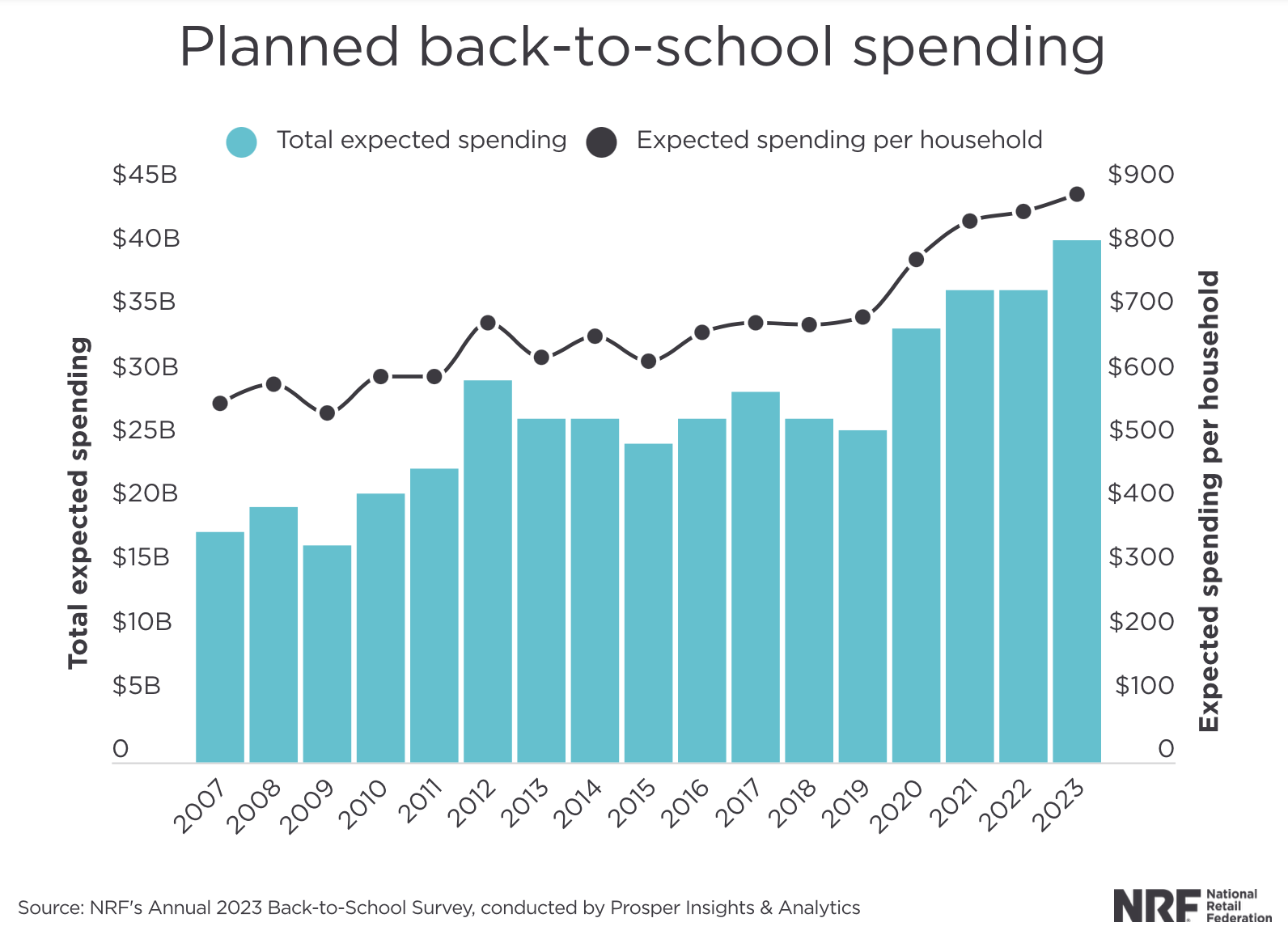Five Ways to Save on Back-to-School Shopping
Make a budget and stick to it when spending on your kids' back-to-school supplies.


Ben Demers
With back-to-school shopping season in full swing, concerns on how to afford clothing and educational supplies are increasing, especially as core inflation remains stubbornly elevated. Back-to-school consumer spending is expected to reach a record $41.5 billion, up from $36.9 billion last year, according to the National Retail Federation's (NRF) latest Back-to-School Survey. The average family with children in grades K-12 will spend about $890 on apparel, shoes, supplies and electronics, surpassing the previous high of $864.
NRF reports that the spending boost is largely driven by increased electronics demand. A record 69% of back-to-school shoppers plan to buy electronics or computer accessories this year, a 4% increase from 2022.

With ever-rising costs weighing on family budgets, here are some tips to save at this pricey time of year:

Sign up for Kiplinger’s Free E-Newsletters
Profit and prosper with the best of expert advice on investing, taxes, retirement, personal finance and more - straight to your e-mail.
Profit and prosper with the best of expert advice - straight to your e-mail.
1) Purge the Closet
Kids grow like weeds. A pair of shoes bought just a month ago might no longer fit. Rummage through clothing to see what fits and what is in good condition. Hang onto what you can to pass on to younger siblings, friends or Goodwill. Everything else can be tossed or recycled for a craft project. Talk to your children to make decisions about what they could reuse. This encourages a youngster to think creatively about how to make things last and not waste.
For supplies, look at what the child has from the previous school year. Do you have unused glue, paper and folders that are in good shape? Reuse them or, if there is another child in the household, give them the materials.
2) Make a Budget
Kids need limits, especially financial limits. Sit down with a child and discuss how much can be spent on clothing, supplies and miscellaneous items such as a laptop or high-tech gadget for class. Ask the child to come up with ways to stretch a buck or contribute to the fund.
If the child is older and wants an expensive pair of shoes, offer to pay for half and have him or her come up with the rest. This kind of conversation can be part of a bigger push to teach kids good money habits. An extra benefit: This gives them practice to earn that A in math.
3) Hit the Thrift Stores
Kids today love a good "throwback" and enjoy finding cool retro items from Goodwill stores or rummage sales. Perhaps as guardian or parent, you may have some items in storage that would appeal to the kids in the household. Grandpa's vintage jean jacket from 1960 might look awesome to a teen on the first day of school.
4) Check Online and on Social Media
Surf the web with your child and see if stores such as Target, Walmart, Office Max, etc. are offering deals via their Twitter, Facebook, Instagram or other social media accounts. Many stores post on upcoming sales targeting back-to-school shoppers. Also look up sites such as Amazon.com or Overstock.com for cheaper versions of higher-end items. Consider it virtual rummage sale shopping.
5) Next Year, Start Early
Back to school time is a rush of papers, book bags and clothing flying off the racks and shelves. Next year, think about starting shopping around March and buying certain items such as winter clothing ahead of time when they're on clearance. While everyone else is thinking spring, you will be a savvy shopper thinking about scoring a decent deal on boots for someone in the family.
Related Content
Get Kiplinger Today newsletter — free
Profit and prosper with the best of Kiplinger's advice on investing, taxes, retirement, personal finance and much more. Delivered daily. Enter your email in the box and click Sign Me Up.

Marguerita M. Cheng is the Chief Executive Officer at Blue Ocean Global Wealth. She is a CFP® professional, a Chartered Retirement Planning Counselor℠ and a Retirement Income Certified Professional. She helps educate the public, policymakers and media about the benefits of competent, ethical financial planning.
- Ben DemersAudience Engagement Manager, Kiplinger.com
-
 5 Easy Weatherproofing Projects That Help Prevent Damage and Save on Insurance
5 Easy Weatherproofing Projects That Help Prevent Damage and Save on InsuranceProtect your home from storms and water damage with these simple weatherproofing upgrades — some may help reduce your home insurance premium.
By Paige Cerulli
-
 If Trump Fires Jerome Powell, What Happens To Savings and Mortgage Rates?
If Trump Fires Jerome Powell, What Happens To Savings and Mortgage Rates?President Donald Trump expressed his desire to remove Fed Chair Jerome Powell. If the president is successful, how would it impact your savings accounts?
By Sean Jackson
-
 Four Takeaways From Filing Your Taxes to Boost Your Financial Future
Four Takeaways From Filing Your Taxes to Boost Your Financial FutureNow that another tax season is in the rearview mirror for most of us, what lessons can you take from what you learned about your finances to plan for the future?
By Kate Winget
-
 What Claims Adjusters Are Thinking vs What They're Saying
What Claims Adjusters Are Thinking vs What They're SayingAfter a natural disaster, few of us are at our best, but here's what to keep in mind when you're interacting with your insurance company's claims adjuster.
By Karl Susman, CPCU, LUTCF, CIC, CSFP, CFS, CPIA, AAI-M, PLCS
-
 Looking to Make a Job Change? How to Stand Out Like a Pro
Looking to Make a Job Change? How to Stand Out Like a ProTo make a strong first impression in interviews or when networking, skip your job title and work history and use an opening gambit that highlights your talents.
By Anne deBruin Sample, CEO
-
 First 100 Days: Trump's Impact on Your Finances
First 100 Days: Trump's Impact on Your FinancesHere are some opportunities to consider regarding investing, interest rates and tax cuts as the financial landscape shifts under the new administration.
By Daniel Razvi, Esquire
-
 Children Can't Afford to Fly the Nest? Here's How to Help
Children Can't Afford to Fly the Nest? Here's How to HelpThe high cost of living means more adult children are staying at home. Here are four ways to help financially so they can eventually spread their wings.
By Kelli Kiemle, AIF®
-
 Should You Hire a Public Adjuster for Your Insurance Claim?
Should You Hire a Public Adjuster for Your Insurance Claim?As natural disasters strike more often, insurance clients are asking, 'What should I do, or who should I hire, if my insurance company is jerking me around?'
By H. Dennis Beaver, Esq.
-
 Home Insurance: How to Cut Costs Without Losing Coverage
Home Insurance: How to Cut Costs Without Losing CoverageNatural disasters are causing home insurance premiums to soar, but don't risk dropping your coverage completely when there are ways to keep costs down.
By Jared Elson, Investment Adviser
-
 Why Homeowners Insurance Has Gotten So Very Expensive
Why Homeowners Insurance Has Gotten So Very ExpensiveThe home insurance industry is seeing more frequent and bigger claims because of weather, wildfires and other natural disasters.
By Karl Susman, CPCU, LUTCF, CIC, CSFP, CFS, CPIA, AAI-M, PLCS